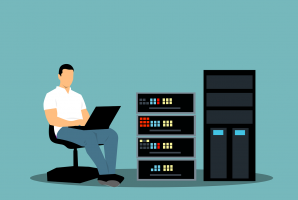Enterprise Resource Planning (ERP) is an old term that evolved with time. Among businesses to drive operational efficiency at reduced costs.
The Birth of ERP
ERP was introduced in the late 90s by ‘The Gartner Group’s industry analyst from the then well-known term – MRP (Material Requirement Planning). This was majorly used by manufacturing industries to streamline their business operations and improvise the decision-making skills of production managers. Further as an advancement to this, ‘The Gartner Group’ worked on expanding this to industries apart from the manufacturing domain. ERP solutions helped enterprises manage their back-office operations, IT-related tasks, inventory handling, scheduling, accounting, and other such operations.
The Rise of ERP
With the advent of time and digitization, ERP solutions developed the capability to integrate with other software like customer relationship management (CRM), human resource management systems (HRMS), supply chain management (SCM), and other related areas. The idea behind this is to consolidate operations from different departments into a single unified ERP software through which, every individual can access the required data. ERP can be presently deployed on two platforms – Cloud and On-Premise. In a cloud-based ERP software, the vendor has the hosting done on its server from which the users can access data through a web browser. While the on-premise ERP solution is hosted locally within the organization.
Currently, the ERP software market in the APAC region is worth nearly $35 billion and it is anticipated to continue growing drastically. ERP solutions are used by industries from different verticals like automobile, manufacturing, aerospace, IT, healthcare, hospitality, food and beverage, tourism, retail, and most others. Due to the customization feature available, it becomes extremely easy for businesses to adopt ERP software and then modify the features based on their requirements and business goals. Also, ERP integration with CRM has helped companies achieve a greater level of profitability through satisfied customers.
Let’s take an example of the manufacturing industry. A typical manufacturing process includes the below steps:
- Wire-framing
- Product design
- Material acquisition
- Quality check
- Statutory Compliances
- Manufacturing
- Delivery
- Recycling
ERP solutions will collaborate data from all these processes in one place for different departments to access, validate, analyze, and produce. All of this calls for increased productivity and reduced operational costs.
Why adopt an ERP solution?
A typical organization usually will have 5-6 departments at least. This will generally include finance and accounting, human resources, development operations, marketing, and sales. All these departments are subtly interconnected. Only when the marketing and sales team will generate leads and close opportunities, the development team can work on product formation which will, in turn, bring in profits. And to create a strong workforce to achieve better revenues, it is important you have experienced people, which comes under human resource management. Hence, we can say that to micromanage these operations without investing time in those tedious spreadsheets, daily/ weekly report meetings, and sticky notes, a unified ERP software that can consolidate all these operations in one place is worth the investment. Eliminating conventional working patterns with the modern and proven approach will help save time and money.
ERP for improved operational efficiency
There are different modules in an ERP software solution. You may either choose or customize the most suitable one for your business data management in real time.
Cost-Effective
ERP software can save up to 20% of your IT spending. With a
cloud-based ERP solution, you can save on the cost incurred in setting up the
data servers. With a single system, the time involved in switching between
disparate systems to gather data for communication get saved which will help
your resources utilize their time to do other jobs in the same duration. Here,
you can save on labor costs too. Additionally, save 10 to 15 percent through
material planning and inventory management features. You might have to invest a
lump sum amount only once at the beginning, but later, you are to witness
healthy returns.
Integration Functionality
An ERP software solution, like this one from Inecta, can collaborate multiple areas into a single module to access all the client, purchase, and inventory-related information. Information stored can be accessed in real-time whenever required without the limitation of being present at a particular place. Also, unlike spreadsheets and sticky notes, the information once stored does not fall to the risk of getting lost.
Comprehensive Planning
With ERP software, you can identify your target audience, set goals and align your actions accordingly. Integrate ERP with CRM to get better results. Design workflows, follow-up schedules, and past communication logs to help understand your brand positioning better and plan likewise.
Reporting
Managers can track everyday activities through ERP software. Instead of manually sending out the reports daily/ weekly, users can automate this process. ERP solutions have automated on-command email-sending functionality for specific days and times. This will free up time for employees and help them focus on more concerned areas.
Statutory Compliances
In manufacturing industries, it is very crucial to keep up with regulatory affairs. Not only manufacturing but automotive, pharmaceuticals, and many more such industries to maintain certain design and production guidelines to help you carry out the process smoothly. Tax-related entries and other such activities can be automated to save time and avoid complexities.
Take Away
An ERP software solution can be an enterprise buddy when it comes to strategic planning, managing complex operations, accessing critical data, and increasing business profitability. The modules present in Enterprise Resource Planning (ERP) software are customizable and can be opted for according to your business needs and goals. Many companies from almost all domains like the automobile, pharmaceuticals, food and beverage, apparel, hospitality, and more have already adopted ERP solutions. The current trends and future market forecasting suggest that investing in ERP software will always prove to be a boon for SMEs to stay ahead of the competition.
Like this:
Like Loading...













 Maximizing your SEO Impact with these few CRO hacks
Maximizing your SEO Impact with these few CRO hacks
This Post is Fulfill of informative content,and provide truth information…
Great Work
I always like your article because your article is collection of truth information, Thanks for sharing this article,….
your post is superb.Usually I never comment on blogs but your article is so convincing that I never stop myself to say something about it. You’re doing a great job Man,Keep it up.